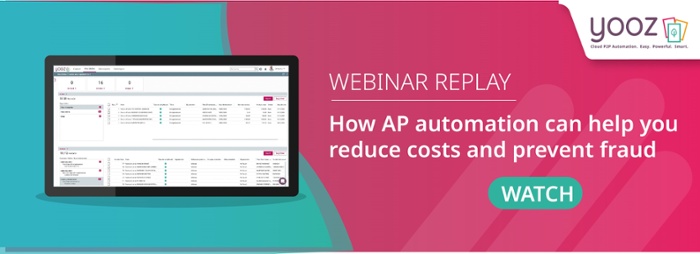The email seemed harmless. It looked like a routine message from a trusted vendor, requesting payment through an attached invoice. But that single email could in fact be the gateway to financial disaster. A single click on the attachment might unleash malware designed to steal usernames, passwords, and sensitive financial data. And the damage wouldn’t stop at the finance department - it could spread across an entire organization, even reaching employees' or customers' personal networks. These type of cyberattacks specifically targeting financial data are on the rise, becoming a nightmare for businesses and CPAs alike.
Fortunately, in this case, the accounts payable (AP) team spotted the phishing attempt and verified the email’s authenticity, preventing a costly breach. But not all companies are as lucky.
As cybercriminals grow more sophisticated, accounting cybersecurity must be a top organizational priority. With AP fraud surging - especially in remote work environments - finance teams must take proactive steps to safeguard financial data from ever-evolving threats.

Countering B2B Payment Fraud
In 2024, an alarming 90% of U.S. companies experienced some form of cyber fraud according to research by Trustpair. This is a significant rise from 79% in 2023. The increase is largely driven by fraudster’s rapid adoption of AI and generative AI tactics such as deepfakes (images or recordings made with AI that look real). The financial consequences were severe, with nearly half of affected companies reporting losses exceeding $10 million.
It's a clear warning that cyber threats are growing more sophisticated, making traditional IT security measures insufficient. Strong cybersecurity measures are essential to safeguard internal data and maintain the customer trust necessary for business growth.
Why Network Security Alone Isn’t Enough
While network security services as a critical first line of defense, it doesn’t safeguard against internal threats like inefficient processes, inadequate approval controls, or error-ridden yet technically clean files. Even the most trusted employee can unknowingly – or intentionally – contribute to vulnerabilities. Common risks include:
-
Weak approval workflows that leave financial controls exposed
-
Human errors in invoice processing, leading to costly mistakes
-
Fraudulent vendor payment requests going undetected
-
Duplicate or manipulated invoices that drain company funds
Without a comprehensive approach of internal controls to reduce these risks and protect data, businesses remain vulnerable to financial loss, data breaches, and reputational damage. The smarter solution? An accounting management system equipped with built-in cyber security features designed specifically to protect AP processes from internal and external threats.
Essential Practices for Accounting Cybersecurity
To effectively protect against cybersecurity risks, accounting firms must adopt a series of basic practices:
- Robust Firewalls and Antivirus Software: These are the first line of defense against unauthorized access and malware.
- Employee Training and Awareness Programs: Regular training sessions help employees recognize and respond to cyber threats, such as phishing (email) attacks.
- Data Encryption: Encrypting sensitive data, both in transit and at rest, ensures that even if data is intercepted, it remains unreadable to unauthorized parties.
- Regular Data Backups: Frequent backups protect against data loss in the event of a cyber attack, allowing firms to restore their systems quickly.
- Access Controls and Multi-Factor Authentication: These measures prevent unauthorized access to sensitive data by requiring multiple forms of verification.
- Regular Audits and Penetration Testing: Conducting these tests helps identify and address vulnerabilities in cybersecurity systems before they can be exploited.
By implementing these practices, organizations can minimize cybersecurity risks and protect their financial data from potential threats.
How Errors and Fraud Can Undermine Security
Cyber fraud doesn't always require advanced tactics. Sometimes, a simple mistake can lead to devastating consequences. For example:

-
Fraudulent vendor requests: A scammer poses as a supplier and requests a bank account update, diverting payments to an unauthorized account.
-
Invoice manipulation: An invoice intended for $1,200 is altered to read $12,000, slipping through unnoticed due to human error.
-
Duplicate payments: A vendor submits the same invoice twice, with slight modifications to avoid detection, leading to overpayment.
Overworked AP teams handling high invoice volumes or managing multiple locations are at higher risk of missing these issues, which can lead to significant financial losses. Without automation, businesses are left relying on manual processes prone to errors and inefficiencies.
Sensitive Data at Risk: What Can Be Stolen in a Data Breach?
Cybercriminals target a wide range of sensitive financial and personal data, including:
-
Account numbers
-
Transaction details
-
Credit card information
-
Bank account details
-
Usernames and passwords
-
Personal and private information
Without proper security measures, this data can be exploited for fraud, identity theft, and financial losses.
Strengthening Data Security with AP Automation
Implementing an AP automation platform can be a crucial part of a comprehensive cybersecurity risk management plan, improving the overall effectiveness of any organization’s cybersecurity controls. How?
An automated AP system improves security by detecting and preventing fraud before it escalates. Cloud-based AP automation platforms are especially useful, as they provide a secure, scalable environment that protects sensitive financial data while offering seamless, centralized access across teams. Key features include:
Digitization
Eliminates paper-based processes by converting any type of document into a structured format for further processing. This enables an organization to go paperless, reducing the risk of misplaced invoices and unauthorized access to sensitive documents.
Big Data & AI
Securely indexes and stores large amounts of financial data in the cloud, ensuring real-time visibility and tracking for every transaction.
Machine Learning (ML)
This subset of artificial intelligence uses all the data fed to the system to automatically learn and improve your business processes with little to no human intervention. It identifies unusual patterns, flags suspicious transactions, and reduces the risk of fraudulent payments. By leveraging the power of the cloud, these systems can continuously learn and improve security protocols.

The Tangible Benefits of AP Automation for Cyber Security
An AI-powered AP automation platform provides built-in security measures that protect against fraud and errors:
- Detects duplicate invoices and fraudulent payment attempts.
- Applies frequency analysis to flag unusual payment activity.
- Establishes strict approval workflows through robotic process automation.
- Maintains detailed audit logs for transaction traceability.
- Alerts AP teams to unauthorized changes in vendor banking details.
Yooz uses AI-driven frequency analysis and robotic process automation to detect duplicate invoices, flag fraud attempts, and enforce strict approval rules. It enhances traceability with detailed access logs and instantly alerts the AP team to vendor bank detail changes or forged documents.
Ensuring Security Across the Entire AP Process
Accounting cybersecurity is an ongoing process, not a one-time task. It starts at the invoice capture stage and continues through every step of the payment workflow. A comprehensive AP automation system strengthens financial security by:
- Enforcing three-way matching to verify invoices against purchase orders and goods received notes, preventing unauthorized payments.
- Conducting real-time invoice validation by cross-referencing vendor records to detect discrepancies or fraudulent activity.
- Ensuring human oversight by flagging high-risk transactions for review before payment approval.
- Implementing final security checks that analyze transaction patterns, volume, and frequency to mitigate fraud risks before payment execution.
With intelligent automation, businesses can proactively detect and help prevent fraud, ensuring compliance and financial security at every stage.
Future-Proofing Financial Security
Investing in AP automation transforms cyber security from a reactive approach to a proactive defense strategy. AI-powered risk management becomes an invisible yet powerful safeguard, ensuring financial transactions remain secure while improving efficiency.
With cyber threats on the rise, now is the time to go beyond basic network security and implement a robust accounting cyber security strategy. Isn’t it time to strengthen your financial defenses?

FAQs
What is accounting cybersecurity?
Accounting cybersecurity involves practices and technologies to protect financial data from cyber threats. It includes encryption, access controls, fraud detection, employee training, and regular audits to prevent financial loss and ensure data integrity.
Why isn't traditional network security enough to protect financial data?
While network security is essential, it doesn’t prevent internal threats like weak approval workflows, human errors, or fraudulent vendor requests. Without additional controls, businesses remain vulnerable to financial loss and reputational damage.
How can AP automation improve cybersecurity for accounting teams?
AP automation strengthens cybersecurity by detecting duplicate invoices, flagging suspicious transactions, enforcing strict approval workflows, and maintaining detailed audit logs. AI-powered platforms analyze payment patterns to prevent financial losses. AI-powered platforms continuously analyze payment patterns, helping finance teams identify fraud before it causes significant damage.






